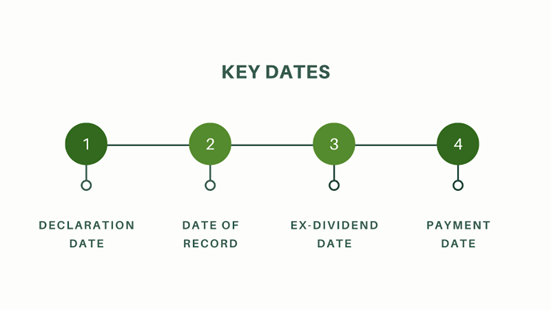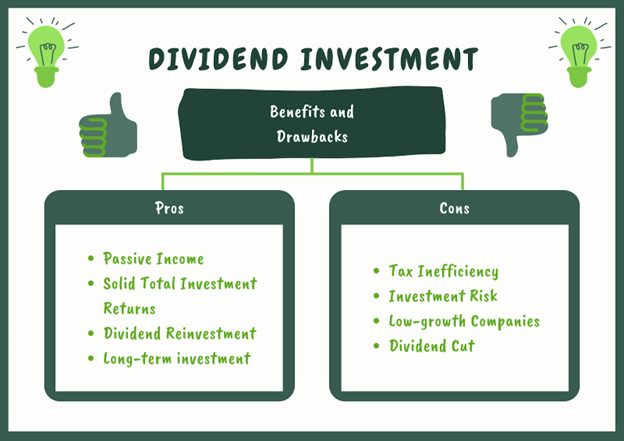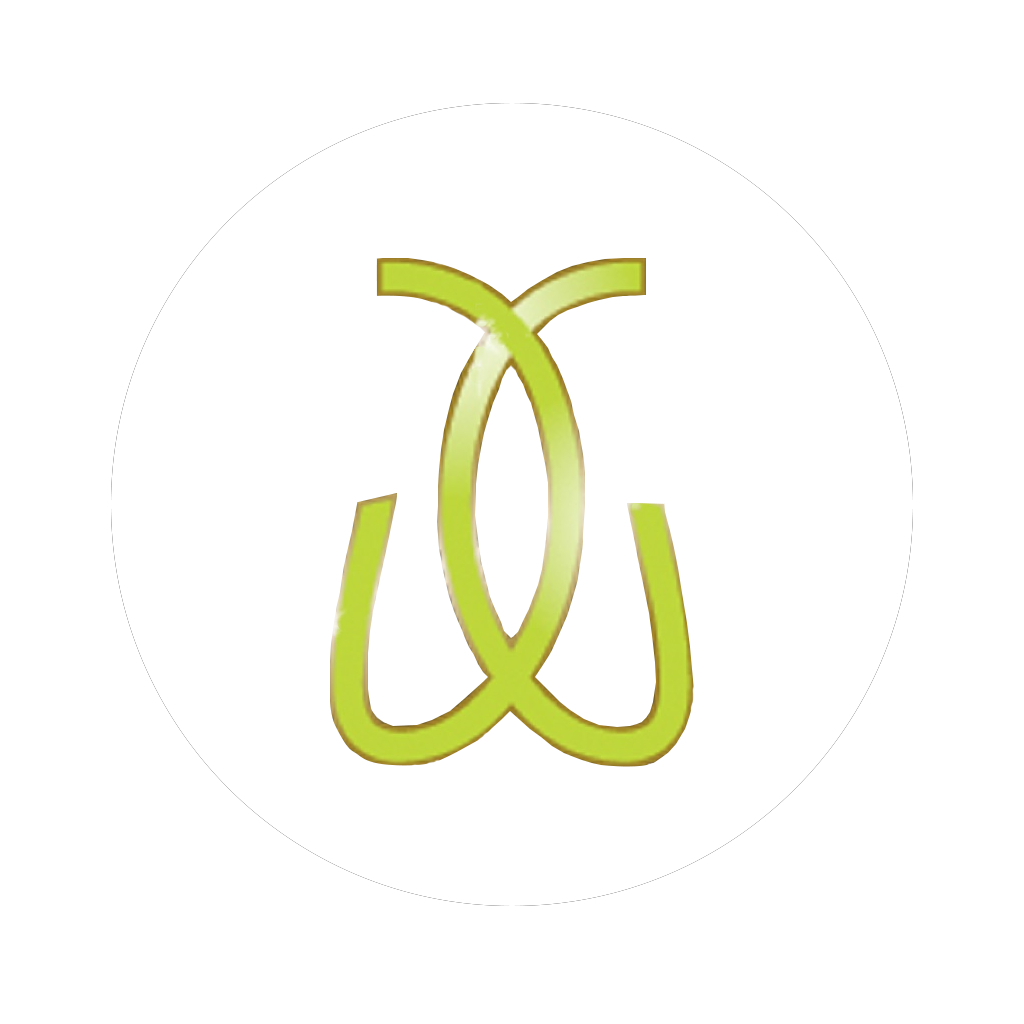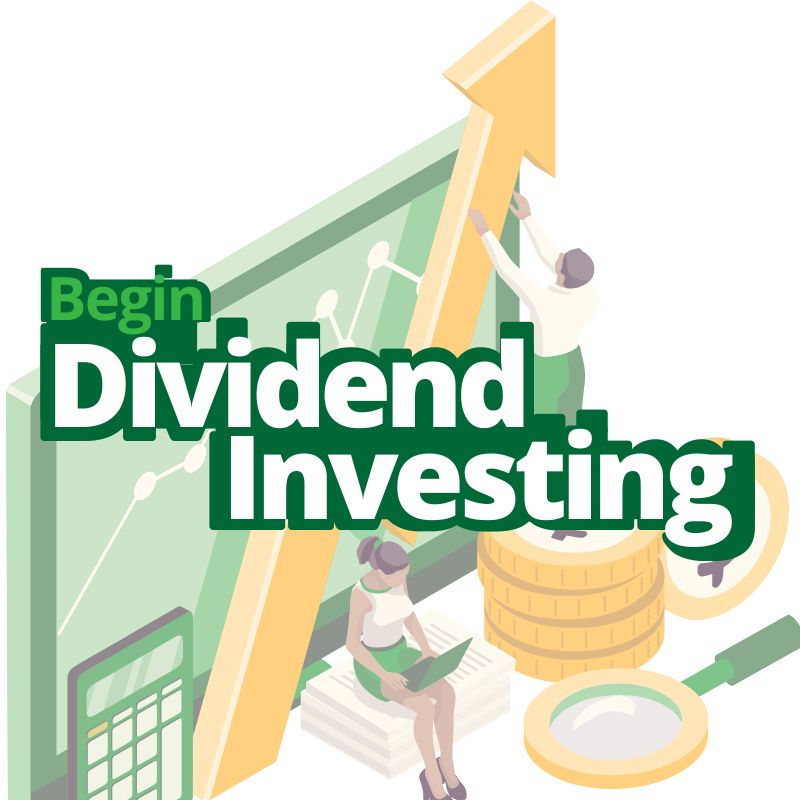No products in the cart.
Financial, Fresh graduate, Young Adult
Profitable Dividend Investing for Beginners: Unlock Financial Freedom 2022
The term “dividend” is often unfamiliar to novice investors relating to investing that involve just single stock or mutual funds. A dividend is a payment made by a company to its shareholders that is decided by the board of directors. Dividend payments are frequently made quarterly and can take the form of cash payments or stock reinvestments. Some profits may be retained by the business to be used for current and future operations. The remainder may be distributed to shareholders as dividends.

Even when the company doesn’t generate enough profits to continue its established track record of distributions, it may still pay dividends. The board of directors has the option to declare dividends at various intervals and various payout rates. Dividends may be paid regularly, such as once a month, once every three months, or once a year.
There are typically two strategies to take into consideration for those interested in dividend investing:
Dividend Yield: Buying stocks or funds with high current dividend yields is the first option. These companies may be undervalued or dealing with some business difficulties. These have caused a decline in their stock price and an increase in dividend yield. In some circumstances, the dividend may be reduced or canceled to address financial issues.
The dividend yield, which is the dividend per share, is expressed as a percentage of a company’s share price, for example, 2.5%. If a common shareholder of a dividend-paying company owns the stock on the ex-dividend date or earlier, they are eligible to receive a distribution.
Dividend Growth: Owning businesses or investment funds that have steadily raised their dividends over time is another option. These stocks typically yield less than high-dividend stocks, but they usually have underlying solid companies with a record of rising earnings.

Mins to Read: 12 minutes
“Do you know the only thing that gives me pleasure? It’s to see my dividends coming in.” – John D. Rockefeller.
You may enjoy many things besides money, but you can still recognize the stabilizing effects that dividends may have on your investment returns. For those who want an income stream without selling their underlying investments, dividends can be a dependable source of income. Reinvesting these relatively small payments can grow into a potent growth engine if you do not require your dividends for your current income. Dividends can increase returns in an upmarket and help balance falling stock prices in a down market because they are positive returns.
What is Dividend Stock?
The equitable distribution of additional shares of a company’s stock to holders of its common stock is known as a stock dividend. In other words, when a company declares a stock dividend instead of a cash dividend, you will receive additional shares of stock. A company may pay out stock dividends for various reasons, such as having insufficient cash on hand or wanting to lower the stock’s price per share. This is to encourage more trading and boost liquidity. Dividends on stocks are also referred to as “stock splits.”
How do Dividend Stocks Work?
Usually, a company’s common stock is used to pay dividends. A company has a variety of dividend options that it can distribute to its shareholders.
Cash Dividends: The most typical dividend kind. The companies typically pay these directly into the shareholder’s brokerage account in cash.
Example of a cash dividend:
A cash dividend of Php 10 per share, payable on May 15, 2022, to shareholders of record as of April 20, 2022, was declared by the board of directors of Company A. The ex-dividend date is April 19, 2022, so you must own the company’s shares before that date.
Let’s say you own 50 shares of Company A, and you bought them for Php 200 apiece for a total of Php 10,000 before April 19. Since the company declared Php 100 per share dividend, you will receive a Php 500 cash dividend (50 shares x Php 5), which will be paid to all shareholders of record on May 15. If the company declares the same quarterly cash dividend each quarter, that equates to a Php 2,000 cash dividend received for the year, assuming you still owned only 50 shares of the company.
Stock Dividends: Companies can give investors more stock in exchange for cash.
Example of a stock dividend:
If Company A issued a 10% stock dividend, your shares would increase by 10%. If you previously had 1,000 shares in the company, you would now have 1,100 shares.
However, neither the company’s nor your stock’s value rises. The value of the existing shares is decreased because the dividend is paid in newly issued stock. This is comparable to what takes place following a stock split.
Dividend Reinvestment Programs (DRIPs): Any dividends received by DRIP investors may be reinvested, frequently at a discount, into the company’s stock.
Example of DRIPs:
You own 1,000 shares in Company A and participate fully (100%) in the company’s dividend reinvestment plan. The company declares a dividend of Php 10 per share payable on December 15. On said date, the market price of the share is Php 100, and the dividend reinvestment plan offers a 15% discount.
On December 10, you receive a cash dividend of Php 10,000 (1,000 shares x Php 10). You fully participate in the DRIP, reinvesting 100% of your cash dividends into additional company shares. On the payment date, the market share price is Php 100. With a 15% discount from the DRIP, You can purchase additional shares at Php 85 (Php 100 x 0.85).
You will now own an additional 117.6471 shares of Company A (Php 10,000 / Php 85) with a purchase price of Php 85 and Php 10,000 in cash dividends. Usually, the fractional amount (0.6471) is carried over to the following dividend payment. Consequently, due to the DRIP, you will now possess 117 more shares, a total of 1,117.
Special Dividends: These dividends, unlike regular dividends, are paid out on all shares of a company’s common stock. A company frequently declares a special dividend to distribute profits that have accumulated over a number of years and for which it has no immediate need.
Example of a special dividend:
If on January 1, 2020, a company announced a special dividend of Php 3 per share on its 5,000,000 shares, payable on January 20, 2020, the following journal entries would be made:
The amount due is Php 15,000,000 (5,000,000 x Php 3). The company first makes a provision or transfers the overdue amount to the payables amount from all of the company’s available reserves and surpluses. The same would then be paid from such a provided or transferred account to the company’s shareholders. The balance in the payable account would be zero following payment of such a dividend amount because the provided sum was distributed to the company’s shareholders.
Preferred Dividends: Payments made to preferred stockholders. A type of stock known as preferred stock performs more like a bond than a typical stock. In contrast to common stock dividends, typically repaid quarterly, preferred stock dividends are typically fixed. The preferred stock dividend is commonly expressed as a percentage of the stock’s par value. The preferred stock par value, therefore, has some economic significance.
Example of preferred stock:
Say that a preferred stock had a par value of Php 100 per share and paid an 8% dividend. To calculate the dividend, you need to multiply 8% by Php 100 (the par value), which comes from an annual Php 8 per share.
If dividend payments are made quarterly, each payment will be Php 2 per share for a total of Php 8 per share in a year. This stock would be referred to as “8% preferred stock.”
When Do Dividends Get Paid?
To be eligible for stock dividends, you merely need to hold shares of the company in a brokerage account or retirement plan. When the dividends are paid, the funds will be automatically deposited into your account.
Companies can pay dividends for various reasons, but typically they do so to distribute their profits to their owners or shareholders. If a company doesn’t have enough business opportunities to reinvest the money itself, it may also look to pay dividends.
Although other schedules are also possible, quarterly dividend payments are the norm. Special dividends are one-time sums of money that shouldn’t be anticipated to happen again.
Each time a dividend is paid, it must be declared (i.e., approved) by the company’s board of directors. Regarding dividends, there are key dates that investors need to be aware of, including:

Declaration Date: The day the Board of Directors declares its intention to pay a dividend. On this date, the company records a liability; as a result, the stockholders are now owed money. The Board shall also specify a date of record and payment date on the declaration date.
Date of Record: An investor must be a “holder of record” to be eligible to receive a dividend payment. The record date is when a company reviews its records to determine who its shareholders are. Ex-dividend (or “ex-rights”) trading for a stock usually starts the second business day before the record date. In other words, the dividend will only be paid to shareholders who own their shares on or before the ex-dividend date. You wouldn’t get the upcoming dividend payment from a company if you bought shares on or after the ex-dividend date. The investor from whom you purchased your shares would.
Ex-dividend Date: The most important date for dividend investors to consider is a stock’s ex-dividend date. Investors must purchase shares of stock before the ex-dividend date if they want to receive the upcoming dividend on that stock. For instance, shareholders who buy a stock on or after the ex-date, Monday, May 5, will NOT be eligible to receive the dividend. On Friday, May 2, or earlier. Stock owners are suitable for the distribution if they owned it one business day before the ex-date.
Payment Date: The dividend will be paid to company shareholders on this date when the money gets credited to investors’ accounts.
The Ex-dividend date search tool allows investors to keep track of stocks that are going ex-dividend between set of dates. Ex-dividend dates are crucial when investing in dividend stocks because you must own a stock before one before it becomes eligible for the stock’s subsequent dividend.
How to Pick Dividend Stocks?
This article can be helpful if you’re attempting to narrow down the top dividend-paying firms. Here, we go through several things to think about when picking dividend-paying stocks.
Avoid seeking out high dividend yields
Find out why a yield is so high before you jump at it. The dividend yield is computed by taking the stock’s current share price and multiplying it by the total annual dividend payouts. If a share price declines, then it’s a poor indicator and can mean that a dividend cut is imminent if a high or rising yield is. On the other hand, if a rising dividend yield is brought on by increasing earnings, that is a considerably more promising indication.
Make sure you understand the reason for the increase before purchasing the shares because dividends often climb in tandem with rising net profits. It is preferred that the dividend yield is between 3% and 5%. If the stock’s yield is below 3%, it won’t generate enough current income. A dividend yield that is far higher than 5% can suggest that future dividend increases won’t be significant. In the worst-case scenario, the payout could be cut.
Evaluate the payout ratio
You can determine how much of a company’s earnings are going toward the dividend by dividing dividends per share by earnings per share. When the payout to shareholders exceeds earnings by more than 100%, the corporation may be able to fund the dividends from available cash, but this may only go on for so long.
If a firm whose stock you own is losing money but continuing to pay dividends, It could be time to sell. In order to avoid a dividend cut, which could drive away investors, dividend payers in financial difficulty may try to finance payouts using borrowed money or depleting cash reserves.
You may calculate the dividend payout ratio based on earnings by dividing earnings per share by dividends per share. A percentage is used to represent it. A reduced dividend payout ratio is a positive indicator. It shows that even in trying times, a corporation can retain or even raise its dividend. Industry-specific acceptable dividend payout ratios exist. 90% or less is acceptable for real estate investment trusts.
Check the balance sheet
High debt levels are an alternative use of funds. If necessary, the corporation will pay its creditors before paying dividends. The current ratio, which compares a firm’s current assets to its current liabilities, is a useful indicator of how well-capable a company is at meeting short-term obligations.
Having a lot of debt can make it harder to continue paying dividends when times are tough. The current ratio, which compares a firm’s current assets to its current liabilities, is a useful indicator of how well-capable a company is at meeting short-term obligations. A decent rule of thumb is to favor companies with a current ratio of 2 or above.
Examine the dividend growth
Generally speaking, you want to look for businesses that have increased their dividends on a consistent basis over the past three, five, or even ten years. In fact, businesses that increase their dividends typically outperform their competitors over time. Additionally, a long track record of consistent dividend increases also helps stocks keep up with inflation, which is particularly advantageous for income-seeking investors.
Making a dividend growth forecast is another way to look at the growth of the company. You base it on these:
- Historical dividend growth in recent years
- The ratio of dividend payouts
- Dividend policy as disclosed by management, if any
- The business’s growth strategy
Having a prediction for dividend growth enables you to do a number of significant tasks.
You might first contrast anticipated dividend growth with your forecast. Any significant changes should be clear. A prediction for dividend increase also helps determine the stock’s worth. You incorporate it into the dividend discount model approach. It serves as a method of valuing dividend stocks. You can estimate and make plans for your future dividend income by knowing a company’s projected dividend increase.
Understand the risk
When looking for dividend payers for your portfolio, you need to take diverse risk factors into account because some sectors offer a more alluring combination of income and growth than others. For instance, stocks from the banking, consumer goods, and utility sectors are renowned for their consistent dividend payments and low volatility, but they also often have limited growth potential. On the other side, dividend-paying tech businesses may offer appealing payouts as well as the potential for greater price gains, but they also frequently exhibit higher levels of volatility.
If you’re a long-term investor, you might be willing to put up with tech’s greater volatility in exchange for its potential for growth and income, but if you’re approaching or have already reached retirement age, you might prefer to stay with dividend payers from less risky industries.
Consider a fund
Consider a mutual fund or exchange-traded fund that focuses on dividends if you are concerned that price decreases could reduce the value of your dividend equities. These funds often invest in firms with a track record of delivering dividends to shareholders, and they can offer a higher degree of diversification than you can get by purchasing a small number of dividend-paying securities.
Pros and Cons
There are benefits and drawbacks to every strategy. Below is a list of some benefits of dividend investing.
- Passive Income
The company pays dividends to its shareholders. It’s a means of income for dividend investors. Dividends are also known as passive income, investment income, dividend income, and portfolio income. Whatever name you choose. A dividend is a money that an investor keeps in their pocket. The investor is free to do whatever they want with the money once they receive it.
- Solid Total Investment Returns
A dividend stock’s share price will typically increase over time. The dividend investor receives an additional return on investment as a result. Additional to the cash dividends received. It results from rising share prices—the process of paying dividends in cash. Additionally, the potential for an appealing total return on investment is created by share price growth.
- Dividend Reinvestment
By reinvesting dividends, the investor can take advantage of the compounding returns. This implies that a dividend investing strategy produces dividends in cash, which are then put back into dividend-paying stocks to increase dividends from dividend payments made in the past. Dividend compounding has enormous power for long-term wealth development. The dividend snowball effect is what some investors refer to.
- Long-term investment
The “buy and hold” method is one of the best ways to profit from stocks. However, while making long-term investments, there might be a few circumstances where the investors could use a little extra cash. If they want to profit from their invested stocks in this situation, selling stocks may be their only choice. However, because dividend stocks provide a consistent income stream, some investors might prefer to hold the stocks for a more extended period and reap the rewards of long-term investing.
The following is a list of some drawbacks of dividend investing.
- Tax Inefficiency
When you contrast growth stocks with dividend stocks, dividends are subject to two taxes, also known as double taxation. When the company paying the dividend makes money, they are the first subject to tax. Second, when the investor receives their dividends, they are taxed once more because taxes are due.
- Investment Risk
Investing in dividend stocks involves risk, especially in contrast to other investments that yield income: bonds, savings accounts, and certificates of deposit. Because stock prices may decline, often by a wide margin, it may also lead to the investment losses of a dividend stock investor. Bonds and savings accounts typically maintain their value better during a challenging economic period.
- Low-growth Companies
The majority of growth companies do not pay dividends to their shareholders. They reinvest their profits in growing their businesses—by opening new plants, expanding into new cities, purchasing new machinery, acquiring small businesses, etc. Large mature companies, on the other hand, do not have as many opportunities, and as a result, they offer their shareholders a sizable profit. Investors who purchase dividend stocks may invest in low-growth businesses that don’t always have high returns.
- Dividend Cut
The worst-case scenario is this. Dividends are not required, and a company is free to stop paying them at any time. Additionally, when a company reduces its dividends, stock price drops significantly because the general public interprets this as bad sign. And because of this, dividend investors may experience difficulties. Additionally, the board of directors frequently has the authority to alter a company’s dividend policy. If the choice is opposed to the current dividend policy, this could hurt dividend investors.


READ MORE RELATED BLOGS!
READ MORE AND SHARE!
TSOK Chronicles: Unleashing Passion, Dedication, and Excellence in 2024
2023 Your Practical Wedding Guide
Investments and Finance Ultimate Guide
If you like this article please share and love my page DIARYNIGRACIA PAGE Questions, suggestions send me at diarynigracia @ gmail (dot) com
You may also follow my Instagram account featuring microliterature #microlit. For more of my artworks, visit DIARYNIGRACIA INSTAGRAM


Peace and love to you.